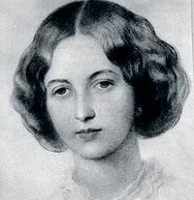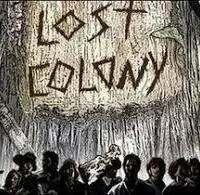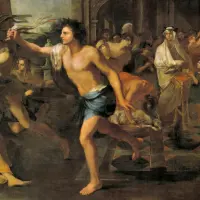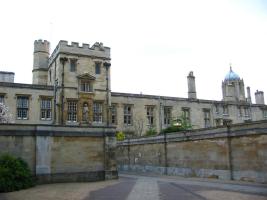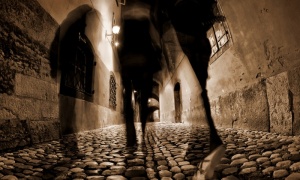October 31 is everyone’s favourite horror holiday – the one time each year when the mundane is overturned in favour of the bizarre and anyone can become anything they wish. Whilst, at its core, Halloween seems to be a chance to confront our most primal fears (and often attempt to mock them!), it is also a holiday which encompasses many other things, including ancient beliefs, religious meanings, a multitude of ethnic heritages, diverse occult traditions and the continual influence of popular culture. Let’s have a look at the history of Halloween and what it means today.
A Treat for All Hallows’ Eve
30 OctHi All,
I couldn’t resist writing an extra post today with Halloween approaching – it is my favourite time of year after all! Bloodbath at the Haunted Manor (click to read!) is another sample of my own work in the form of an extract from a soon-to-be-published ghost story. Set in Blenheim Palace, a mansion rich in history which is located just outside Oxford and is perhaps the country’s most impressive stately home, the story is inspired both by my own student experiences and a famous local legend. I hope you enjoy it and, if nothing else, that the ghostly theme won’t put any would-be tourists off visiting Blenheim Palace, which is well worth a look-in for its gardens alone.
If you’re a fan of this site and/or my e-book, don’t forget that you can follow me on Twitter and Facebook, as well as visiting my UK & US Amazon Listings, by clicking on the links in the sidebar.
Do tune in this time tomorrow for a post which, in keeping with the Halloween season, will be my own take on the history of everyone’s favourite horror holiday!
That’s all folks 🙂
October Dreams
29 OctLooking for something to read over the Halloween season? Then look no further than October Dreams, by some distance the most impressive Halloween-themed anthology that I’ve ever read (and believe me, I’ve read a lot of them!). Full of classic novellas, never-before-published short stories, essays on the history, literature and films of Halloween – and favourite real-life memories of the holiday – all from the world’s foremost practitioners of fear, including Dean Koontz, Peter Straub, Ray Bradbury, Tim Lebbon, Richard Laymon and Ramsey Campbell. This isn’t just a good read, it’s also a collector’s item.
A Conspiracy of Titanic Proportions?
27 OctRMS Titanic was a passenger liner that struck an iceberg on her maiden voyage from Southampton to New York City, and sank on 15 April 1912, resulting in the deaths of 1,517 people in one of the deadliest peacetime maritime disasters in history. Several legends and myths surround the ship and the events of the sinking. The official explanation for the sinking (which is not to say that it is widely accepted) is that the ship struck an iceberg, buckling the hull and allowing water to enter the ship’s first five watertight compartments. Alternative theories which have been suggested as the cause of the disaster range from unsafe speed, an insurance scam, an ice-pack rather than an iceberg, and even a curse on the ship by a Mummy!
The Haunted Bookshop
26 OctHi All,
Check out my guest post The Haunted Bookshop on the excellent blogsite The Write Place, The Write Time of talented fellow writer Tiffany Dickerson.
Enjoy!
Algernon Blackwood – The Ghost Man
25 Oct
Born in London the son of a nobleman, Algernon Blackwood (1869-1951) was nevertheless a rebel against conformity and turned his back on a strict religious upbringing to travel across North America in his twenties, almost starving in the process. Eventually he made his living as a reporter and short story writer in New York, where his output included travel, adventure, humour and some work of a semi-mystical nature. Like his contemporary Arthur Machen, another writer of supernatural fiction, Blackwood became a member of one of the factions of the Kabbalistic order, the Hermetic Order of the Golden Dawn. His interest in the supernatural led him to investigate several haunted houses and start writing the stories which made him famous in the form of several collections of tales of the psychic and the macabre, beginning with The Empty House and other Ghost Stories, which appeared in 1906, and culminating in Tales of the Uncanny and Supernatural in 1949. His reputation grew with radio and television appearances, earning him the epithet ‘The Ghost Man’.
A Halloween Tale
23 OctHi all,
Just a short one today. With Halloween approaching rapidly, I thought I’d treat (see what I did there?!) you all to some of my own work in the form of a sample from one of my own Halloween-themed stories. You won’t find The House on Banbury Road (click to read!) in the Ghosts in the Cloisters e-book which has been published but the full version of the story will be in the soon-to-be published paperback, which will also contain several more unpublished stories as well as a wealth of other material from this website and beyond (so watch this space!).
Regrettably, since the life of a writer is a busy one (especially when you also have a day job), the posts on this blog will henceforth be going out every other day rather than daily, as they have until now. Fear not, however, for I have lots of weird and wonderful ideas for posts going forward and I hope you all continue to enjoy and keep reading Ghost Cities.
Bye for now 🙂
Oxford Ghosts
22 OctMoonheart
21 OctCharles de Lint’s Moonheart is a little bit special. As it says on the back cover blurb “They found them in the back of the little old antiques shop…” and, similarly, I found this book in the back of a little old bookshop in the town where I grew up and have never got sick of reading and re-reading it in all the years since. This was the first Charles de Lint book I ever read and it contains all of the things that his fans have come to know and love – ordinary people thrust into the world of magic that lies on their doorstep, ancient myths walking the modern streets, music, magic, folklore, humour, warmth, imagination and much else besides – dare I say it, better than any book that he has written since. If it’s not too bold a claim, Moonheart is also in my view important because it is one of those few rare books which actually kick-started an entire genre – that of ‘urban fantasy’ – and though De Lint has had many imitators he has never been bettered in this field.
Did Joan of Arc return from the dead?
20 Oct
Since the age of thirteen Joan of Arc had heard heavenly voices, as a result of which she regarded herself as a messenger from God, sent to save the French from their English enemies. She went on to have a brief but spectacular military career, winning many remarkable victories in the space of a year. But in the end Joan was captured by the English, tried as a witch and on 30 May 1431 was burnt at the stake at the age of just nineteen. But that, oddly enough, was apparently not quite the end of the Maid of Orleans.


